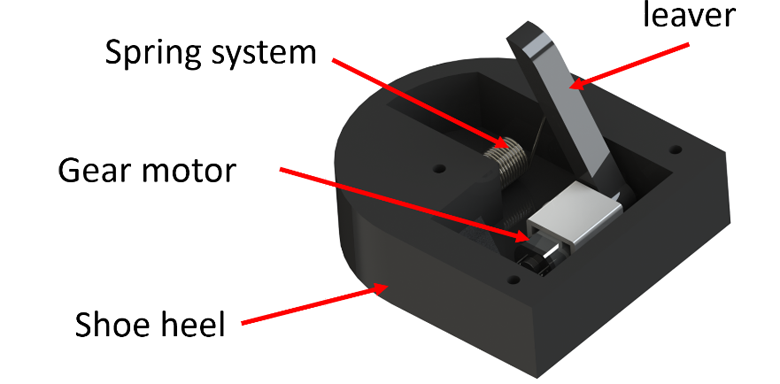George Cowman, Zhiqiang Zhang
The value of the global wearable electronics market is expected to exceed $8 billion in 2018, while the total unit shipment is expected to grow to more than 130 million units globally [1]. In this growing market one of the main challenges for further development is how to provide enough energy for these electronic devices to run over a reasonable amount of time without making the battery too large or the device bulky [2]. This challenge is driving research into various solutions, such as supercapacitor-based energy storage, wireless power transfer and high-density chemical batteries etc. However, among these solutions, wearable energy harvesting generators are the most attractive option as they provide an inexhaustible replacements for batteries for low-power wearable electronic devices.
Thus far, different ambient energy source, such as light, heat or vibration have been explored for energy harvesting. Among them, the wearable kinetic energy harvesting owns the advantage of being clean, stable, and of small size in comparison with others. The human body, in particular the human gait offers a myriad of kinetic sources to parasitically scavenge energy with minimal discomfort. For example, foot strikes of a 68kg person can produce upwards of 13W when walking at 2 steps per second [3]. A well designed energy harvesting shoe could instead turn this energy into electricity, without altering the comfort or energy expenditure of the person wearing the shoe.
The commonly used mechanisms for converting human kinetic energy into electricity are piezoelectric, electrostatic and electromagnetic conversions [4].
- Piezoelectric generators convert Kinetic energy from vibrations or shocks into electrical energy by means of the piezoelectric effect [5]. It utilize piezoelectric materials, such as PZT and PVDF, to produce electrical charges on the surfaces when subjected to mechanical loads. However, it is commonly regarded that the piezoelectric devices can provide high voltage and low currents resulting only tens of microwatts power harvested due to the small changes in the strain of piezoelectric materials.
- Electrostatic generators are taken as capacitors comprising of two conductive plates that are electrically isolated via air, vacuum or a dielectric insulator. Typical examples include dielectric elastomer generator (DEG), which harvests energy through a capacitance change induced by deformation and happens in cycles [5]. When the DEG is compressed by an external mechanical load, the thickness of the dielectric decreases and the electrode area increases, both resulting in an increase in capacitance. The energy conversion happens when a stretched DEG is relaxed to reduce its capacitance. If charge is trapped on the generator before the relaxation phase, there will be an increase in energy. However, the electrostatic generators require an external battery to charge up the capacitor to an initial voltage for the conversion process to start.
- Electromagnetic generators make use of Faraday’s law of induction to generate energy when a wire is moved relative to a magnetic field. Both reciprocation and vibration schemes have been applied to cause repetitive relative movement between coil and magnet. Unlike the electrostatic generators, electromagnetic systems do not require any external input voltage source to initiate power generation, but the miniaturized electromagnetic energy harvesters can only generate very low voltage typically between 0.1 and 0.2 V due to small relative movement between coil and magnet.
Electromagnetic generators approach has been applied at University of Leeds and a prototype of the generator integrated at the shoe heels, as shown in the Fig 1, has been developed to significantly improve the voltage (can reach 2.5v, and can generate approximately 33mJ/step ) that an electromagnetic generator can produce. In the prototype system, the gear-box will transfer the low input speed to a higher output speed which will turn the motor at a much faster rate. The gear motor was placed on the heel of the shoe, allowing the large weight of the person to turn the gear-motor. As the heel reaches the ground the leaver connected to the gear-motor is compressed by 30°, this compression turns the gear-motor outputting an induced voltage. When the heel is lifted the torsion spring pushes the leaver back into the original position, ready for the next strike on the ground. Within this process the gear-motor is also turned and so induces a small voltage, allowing a double harvesting period to occur for one heel strike to the ground. This process is then repeated for each heel strike to the floor in a persons’ walking cycle. The electrical energy converted from the kinetic energy of the heel mechanism, is output with an Alternating Current (AC). Therefore, an AC to DC converter is included in the prototype system to power DC electrical devices.

Figure 1: The illustration of integration micro-electromagnetic generator at shoe heels
Although energy harvesting has been explored a lot for large scale energy conversion, such as ocean waves and winds, the wearable generator is a relatively new concept for energy solutions in wearable electronics. However, with the rapid advances in ultra-low energy microcontroller and wearable technologies, wearable generators are emerging as the future inexhaustible energy solution for low-power wearable electronics.
References
- Wearable Electronics Market to Hit US$8 Billion Value by 2018, [online] RnRMarketResearch.com
- Three Technologies for Harvesting Ambient Energy, [online], spectrum.ieee.org
- McKay et al., 2012.A technology for soft and wearable generators. INTECH Open Access Publisher.
- Mitcheson et al., 2008. Energy harvesting from human and machine motion for wireless electronic devices. Proceedings of the IEEE, 96(9), pp.1457-1486.
- Dorsch et al Towards a Miniaturized, Impulse-excited Piezoelectric Energy Harvesting Device. Procedia Engineering, 120, pp.1032-1036.
- Vertechy et al., 2015. Dielectric elastomers for wave energy harvesting. SPIE Newsroom.
This article was included in an EMBS Weekly Newsletter in April 2017.
